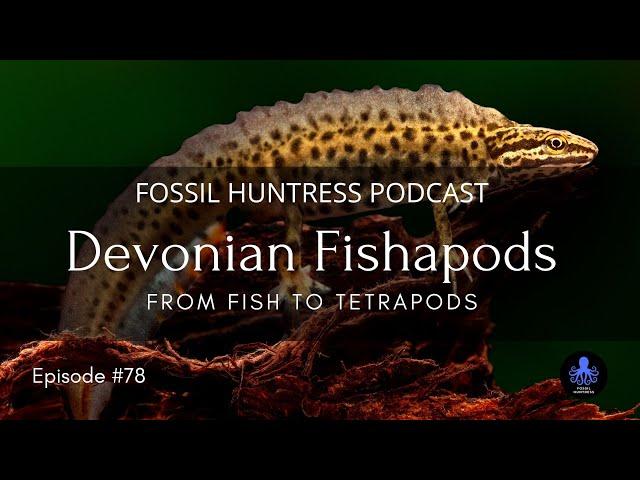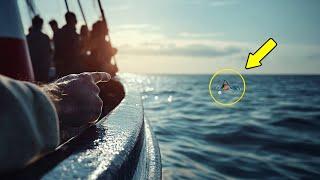
Fossil Huntress Podcast: From Fish to Tetrapods / Episode #78
In the late 1930s, our understanding of the transition of fish to tetrapods — and the eventual jump to modern vertebrates — took an unexpected leap forward. The evolutionary a'ha came from a single partial fossil skull found on the shores of a riverbank in Eastern Canada.
Meet the Stegocephalian, Elpistostege watsoni, an extinct genus of finned tetrapodomorphs that lived during the Late Givetian to Early Frasnian of the Late Devonian — 382 million years ago. Elpistostege watsoni — perhaps the sister taxon of all other tetrapods — was first described in 1938 by British palaeontologist and elected Fellow of the Royal Society of London, Thomas Stanley Westoll. Westoll's research interests were wide-ranging.
He was a vertebrate palaeontologist and geologist best known for his innovative work on Palaeozoic fishes and their relationships with tetrapods. As a specialist in early fish, Westoll was asked to interpret a single partial skull roof discovered at the Escuminac Formation in Quebec, Canada.
His findings gave us the publication that would name Elpistostege watsoni and helped us to better understand the evolution of fishes to tetrapods — four-limbed vertebrates — one of the most important transformations in vertebrate evolution. Hypotheses of tetrapod origins rely heavily on the anatomy of a few tetrapod-like fish fossils from the Middle and Late Devonian, 393–359 million years ago. These taxa — known as elpistostegalians — include Panderichthys, Elpistostege and Tiktaalik — none of which has yet revealed the complete skeletal anatomy of the pectoral fin.
None until 2010, that is when a complete 1.57-metre-long articulated specimen was described by Richard Cloutier et al. in 2020. The specimen helped us to understand the origin of the vertebrate hand. It revealed a set of paired fins of Elpistostege containing bones homologous to the phalanges (finger bones) of modern tetrapods and is the most basal tetrapodomorph known to possess them. Once the phalanges were uncovered, prep work began on the fins.
The fins were covered in scales and lepidotrichia (fin rays). The work was tiresome, taking more than 2,700 hours of preparation but the results were thrilling. We could now clearly see that the skeleton of the pectoral fin has four proximodistal rows of radials — two of which include branched carpals — as well as two distal rows organized as digits and putative digits.
Despite this skeletal pattern — which represents the most tetrapod-like arrangement of bones found in a pectoral fin to date blurring the line between fish and land vertebrates — the fin retains lepidotrichia (those wee fin rays) distal to the radials. This arrangement confirmed an age-old question — showing us for the first time that the origin of phalanges preceded the loss of fin rays, not the other way around. This was evidence for the origins of the vertebrate hand that you and I use today.
Meet the Stegocephalian, Elpistostege watsoni, an extinct genus of finned tetrapodomorphs that lived during the Late Givetian to Early Frasnian of the Late Devonian — 382 million years ago. Elpistostege watsoni — perhaps the sister taxon of all other tetrapods — was first described in 1938 by British palaeontologist and elected Fellow of the Royal Society of London, Thomas Stanley Westoll. Westoll's research interests were wide-ranging.
He was a vertebrate palaeontologist and geologist best known for his innovative work on Palaeozoic fishes and their relationships with tetrapods. As a specialist in early fish, Westoll was asked to interpret a single partial skull roof discovered at the Escuminac Formation in Quebec, Canada.
His findings gave us the publication that would name Elpistostege watsoni and helped us to better understand the evolution of fishes to tetrapods — four-limbed vertebrates — one of the most important transformations in vertebrate evolution. Hypotheses of tetrapod origins rely heavily on the anatomy of a few tetrapod-like fish fossils from the Middle and Late Devonian, 393–359 million years ago. These taxa — known as elpistostegalians — include Panderichthys, Elpistostege and Tiktaalik — none of which has yet revealed the complete skeletal anatomy of the pectoral fin.
None until 2010, that is when a complete 1.57-metre-long articulated specimen was described by Richard Cloutier et al. in 2020. The specimen helped us to understand the origin of the vertebrate hand. It revealed a set of paired fins of Elpistostege containing bones homologous to the phalanges (finger bones) of modern tetrapods and is the most basal tetrapodomorph known to possess them. Once the phalanges were uncovered, prep work began on the fins.
The fins were covered in scales and lepidotrichia (fin rays). The work was tiresome, taking more than 2,700 hours of preparation but the results were thrilling. We could now clearly see that the skeleton of the pectoral fin has four proximodistal rows of radials — two of which include branched carpals — as well as two distal rows organized as digits and putative digits.
Despite this skeletal pattern — which represents the most tetrapod-like arrangement of bones found in a pectoral fin to date blurring the line between fish and land vertebrates — the fin retains lepidotrichia (those wee fin rays) distal to the radials. This arrangement confirmed an age-old question — showing us for the first time that the origin of phalanges preceded the loss of fin rays, not the other way around. This was evidence for the origins of the vertebrate hand that you and I use today.
Комментарии:
Fossil Huntress Podcast: From Fish to Tetrapods / Episode #78
ARCHEA: Fossil Huntress Musings in Natural History
Free Fire Gameplay Telugu Videos | VEGGALAM ABHISHEK CHARY TECH | GARENA FREE FIRE ONLINE GAMING APP
VEGGALAM ABHISHEK CHARY TECH
Видео-урок (I-полугодие: декабрь 2018г.) - филиал Червишевский, Детская хореография, гр.4-6
Бренд-агентство «Кузьминская консалтинг»
#Dominaike
Danna Iveth
Session #96 - Shalomalaykum [Piccaya]
Kosmozoo Music
My EX Sent Me A LOVE POEM PRANK! *SHE DISSES MY FIANCÉE*
Kristen & Reafe
Bifilm - Ahtapotçu İmaj Filmi
Bi’film Prodüksiyon
Neds - He's Fucking Class
johnmacdee





![Session #96 - Shalomalaykum [Piccaya] Session #96 - Shalomalaykum [Piccaya]](https://invideo.cc/img/upload/RXUzUlRpLUQ0TUU.jpg)




















